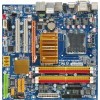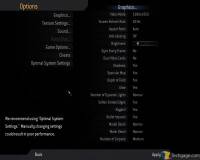- Qualcomm Launches Snapdragon 4 Gen 2 Mobile Platform
- AMD Launches Ryzen PRO 7000 Series Mobile & Desktop Platform
- Intel Launches Sleek Single-Slot Arc Pro A60 Workstation Graphics Card
- NVIDIA Announces Latest Ada Lovelace Additions: GeForce RTX 4060 Ti & RTX 4060
- Maxon Redshift With AMD Radeon GPU Rendering Support Now Available
Gigabyte EG45M-DS2H

On the test bench today, we have Gigabyte’s latest Micro ATX offering, the Intel G45-based EG45M-DS2H. This board carries the typical Gigabyte enthusiast charm, but also caters towards those looking to build a media center. But how does it stack up against the other Intel mATX boards we’ve tested recently?
Page 5 – Test System & Methodology
At Techgage, we strive to make sure our results are as accurate as possible. Our testing is rigorous and time-consuming, but we feel the effort is worth it. In an attempt to leave no question unanswered, this page contains not only our testbed specifications, but also a fully-detailed look at how we conduct our testing.
If there is a bit of information that we’ve omitted, or you wish to offer thoughts or suggest changes, please feel free to shoot us an e-mail or post in our forums.
Test System
The table below lists our machine’s hardware, which remains unchanged throughout all testing, with the exception of the motherboard. Each board used for the sake of comparison is also listed here, along with the BIOS version used. In addition, each one of the URLs in this table can be clicked to view the respective review of that product, or if a review doesn’t exist, you will be led to the product on the manufacturer’s website.
|
Component
|
Model
|
| Processor |
Intel Core 2 Duo E7200 – Dual-Core, 2.50GHz, 1.25v
|
| Motherboards |
ASUS P5E-VM HDMI – G35-based
Gigabyte EG45M-DS2H – G45-based, F2 BIOS (07/18/08) Intel DG45ID – G45-based |
| Memory | |
| Graphics |
Intel GMAX4500HD (G45-based boards; Driver 7.15.10.1554)
Intel GMAX3500 (G35-based boards; Driver 7.15.10.1554) |
| Audio |
On-Board Audio
|
| Storage | |
| Power Supply |
PC Power & Cooling Silencer 500W
|
| Chassis | |
| Display |
Dell Ultrasharp 2208WFP 22″ Widescreen
|
| Cooling | |
| Et cetera |
*The 32-bit version of Windows Vista Ultimate is used for SYSMark 2007 testing.
When preparing our testbeds for any type of performance testing, we follow these guidelines:
-
General Guidelines
- No power-saving options are enabled in the motherboard’s BIOS.
- Internet is disabled.
- No Virus Scanner or Firewall is installed.
- The OS is kept clean; no scrap files are left in between runs.
- Hard drives affected are defragged with Diskeeper 2008 prior to a fresh benchmarking run.
- Machine has proper airflow and the room temperature is 80°F (27°C) or less.
-
Windows Vista Optimizations
- User Account Control (UAC) and screen saver are disabled.
- Windows Defender, Firewall, Security Center, Search, Sidebar and Updates are disabled.
To aide with the goal of keeping accurate and repeatable results, we alter certain services in Windows Vista from starting up at boot. This is due to the fact that these services have the tendency to start up in the background without notice, potentially causing slightly inaccurate results. Disabling “Windows Search” turns off the OS’ indexing which can at times utilize the hard drive and memory more than we’d like.
Application Benchmarks
When benchmarking a graphics card or processor, performance is expected to scale in a certain manner, but that’s not the case with motherboards. Since motherboards tend to only be as fast as the hardware installed on them, we don’t run an exhaustive collection of benchmarks for the sake of avoiding redundancy. For the most part, one motherboard with an equal chipset to another should offer close to equal performance.
Our primary goal with motherboard-related benchmarking is to see if one motherboard is lacking in a certain area when compared to the rest. These discrepancies, if they exist, are usually caused by lackluster components on the board itself, which is why higher-end motherboards tend to see slightly better results than the more budget-oriented offerings.
To properly test the performance of a motherboard, we run a small collection of system-specific tools, such as SYSmark 2007, Sandra and HD Tune Pro. We then run real-world benchmarks using popular multi-media applications, such as Adobe Lightroom. To see how a board stacks up in the gaming arena, we benchmark using both Call of Duty: World at War and Half-Life 2: Episode Two.
We strongly feel that there is such thing as too many benchmarks when it comes to a motherboard review, so we keep things light, while still being able to offer definitive performance data.
Game Benchmarks
In an attempt to offer “real-world” results, we do not utilize timedemos in any of our reviews. Each game in our test suite is benchmarked manually, with the minimum and average frames-per-second (FPS) captured with the help of FRAPS 2.9.6.
To deliver the best overall results, each title we use is exhaustively explored in order to find the best possible level in terms of intensiveness and replayability. Once a level is chosen, we play through repeatedly to find the best possible route and then in our official benchmarking, we stick to that route as close as possible. Since we are not robots and the game can throw in minor twists with each run, no run can be identical to the pixel.
Each game and setting combination is tested twice, and if there is a discrepancy between the initial results, the testing is repeated until we see results we are confident with.
The two games we currently use for our motherboard reviews are listed below, with direct screenshots of the game’s setting screens and explanations of why we chose what we did.
Half-Life 2: Episode Two
Editor’s Note: In this article, we won’t be testing under Half-Life 2 as usual, because of known issues when running on the Intel G45 chipset. The issue is driver-related, but the bottom line is that the game simply won’t run on G45 at the 1680×1050 resolution that we consider the ‘minimum’ today. Even many 19″ widescreen monitors are moving to a native resolution of 1680×1050, so it’s disappointing that Intel still hasn’t managed to fix their drivers by this point.
Call of Duty 4: Modern Warfare
To further put the motherboard’s integrated graphics core to the test, we run through a level of Activision’s Call of Duty 4: Modern Warfare. CoD4 is run at a resolution of 1680×1050 pixels, which we feel is the highest reasonable resolution to attempt with an IGP, and corresponds to the native resolution of most 20″-22″ widescreen monitors.
|
1680×1050
|
On the next page, we’ll kick off our results with SYSmark 2007 Preview.
Support our efforts! With ad revenue at an all-time low for written websites, we're relying more than ever on reader support to help us continue putting so much effort into this type of content. You can support us by becoming a Patron, or by using our Amazon shopping affiliate links listed through our articles. Thanks for your support!





